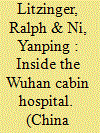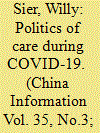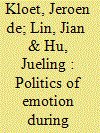|
|
|
Sort Order |
|
|
|
Items / Page
|
|
|
|
|
|
|
| Srl | Item |
| 1 |
ID:
182977


|
|
|
|
|
| Summary/Abstract |
A virus is not only invisible; it is also inaudible. Alongside attempts to visualize COVID-19, this article inserts a sonic perspective to listen to encounters between authorities and populations during the pandemic in China. The article examines how sound (mal)functions to mediate, interpellate, and distribute authority and power in the name of national health and safety. We will concentrate on the use of sirens and loudspeakers. First, at 10 a.m. on 4 April 2020, sirens were sounded throughout the nation to mark an official National Day of Mourning (全民哀悼日). Second, to reach places not readily accessible by more modern means of communication, rural leaders resorted to loudspeakers to announce virus-related messages to offline populations. Our curiosity about the sonic element was piqued. At the same time, we were reminded of ocularcentrism – the tendency or the bias to place the visual at the centre of inquiry. We argue for the need to engage with sonic practices and politics, and to foreground sound as a tool of governmentality. We want to document how certain instances of sonic governmentality played out in China during the pandemic. Finally, this inquiry should help us explore possible avenues for future research on sound and politics.
|
|
|
|
|
|
|
|
|
|
|
|
|
|
|
|
| 2 |
ID:
182974


|
|
|
|
|
| Summary/Abstract |
How can we combat the invisible – a virus one can only see with the aid of sophisticated equipment? A virus that has nevertheless managed to put the world on hold, freeze our travelling, and a virus that has killed, at the time of writing – July 2021 – over 4 million people worldwide.1 A virus, moreover, whose first recorded outbreak started in mainland China at the end of 2019. What seemed like yet another local health crisis soon morphed into a global pandemic. Since the start of the pandemic, China's role has shifted. Initially, China was the assumed ‘origin’ of the pandemic, and was criticized for its secretive attitude about the source and spread of the virus.
|
|
|
|
|
|
|
|
|
|
|
|
|
|
|
|
| 3 |
ID:
182976


|
|
|
|
|
| Summary/Abstract |
This article explores how competing actors established, spread, and challenged visual representations of the Chinese nation during the COVID-19 pandemic. It asks: how do official gatekeepers of meaning in China imbue their visual construction of a crisis-hit nation with pathos?; and what happens when their critics utilize the resulting repertoire of visual cues for their own ends? To answer these questions, the article first examines the visual libraries of nationalism and national crisis from which Chinese propaganda drew during the COVID-19 outbreak. It then analyses the struggles that ensued over such representations, specifically the use of national flags and the sentiments they elicit. The analysis traces representations of the flag of the People’s Republic of China (PRC) from an initial satirical portrayal in a Danish broadsheet to the angry Chinese backlashes that followed on social media, and it shows how the tensions over such portrayals became part of a meme war over the sovereignty of Hong Kong. The analysis shows how representations of the nation can become a matter of existential anxieties during a time of crisis, especially in highly networked communication environments where authoritative official actors and their supporters are no longer in control of the symbols they established as part of their ‘emotional governance’.
|
|
|
|
|
|
|
|
|
|
|
|
|
|
|
|
| 4 |
ID:
182980


|
|
|
|
|
| Summary/Abstract |
This article examines a humorous meme that emerged on Chinese TikTok during the COVID-19 pandemic in China. Using #workfromhomewithchildcare, Chinese working mothers shared humorous clips of their experience of working from home with their children who were also at home during the pandemic lockdown. By analysing the themes, protagonists, and humour techniques of a sample of 85 videos, we ask why the mood of these clips is so strongly marked by humour, and what this tells us about contemporary Chinese society, particularly about the position of women and mothers. We show that these memetic clips consist of three distinct genres of mothers working from home: (1) ‘balancing mothers’ who balance between work and childcare, (2) ‘pedagogic mothers’ who give childcare tips, and (3) ‘commercially oriented’ mothers who offer tutorials by means of product placement and advertisement. While these memes express what Mary Douglas called ‘a joke in the social structure’ without offering either relief or critique, they do create an online joking culture that offers temporary relief as well as awareness that others are in the same position. Our analysis tempers enthusiastic claims about both the critical potential of humour and the new ‘liberating’ affordances offered by digital platforms to produce liberating female spaces.
|
|
|
|
|
|
|
|
|
|
|
|
|
|
|
|
| 5 |
ID:
182978


|
|
|
|
|
| Summary/Abstract |
This article examines the making and circulation of vlogs on the Chinese platform Douyin during the Wuhan lockdown. We specifically draw attention to vlogs made in mobile cabin hospitals. Constructed between February and March in 2020, cabin hospitals were part of the state’s isolation and quarantine efforts, and these hospitals created spaces of confinement within a city under lockdown. The vlogs that we refer to are often bursting with energy, optimism, and play, and seem to be expressive of new modalities of care and social relationality. But they are also appropriated by the Chinese state, who used them as examples of ‘positive energy’ (正能量), and to promote the collective commitment to contain the virus. Focusing on the videos, blogs, and narrative storytelling of Li Jing, we show how the state appropriated her work to further its attempt to control the meaning of life and death during the ‘people’s war’ on the coronavirus. These and other state appropriations must also be understood within the context of the state’s involvement in platforms such as Douyin and the ‘platformization’ of everyday life both before and during the Wuhan lockdown.
|
|
|
|
|
|
|
|
|
|
|
|
|
|
|
|
| 6 |
ID:
182975


|
|
|
|
|
| Summary/Abstract |
This article employs the concept of care as a lens through which to examine the anti-COVID-19 measures taken in post-lockdown Wuhan. Based on photographs that depict the Chinese response to COVID-19 at the epicentre of the virus outbreak, the article analyses the visibility of anti-virus measures as a form of government communication inscribed textually and symbolically onto the urban landscape. The state demonstrates its care and capability by implementing highly visible high-tech measures to contain the virus. Bringing care into the literature on crisis management in China sheds light on the Chinese state’s reaction to COVID-19 in eliciting nationalist sentiments and positive feelings of cooperation while stigmatizing critical voices as uncooperative and unpatriotic. It shows that care is central not only to the functioning of liberal democracies: the Chinese state also relies on narratives about care to showcase the superiority of its political system and to distinguish between desirable and unwanted forms of citizens’ political engagement after the COVID-19 outbreak.
|
|
|
|
|
|
|
|
|
|
|
|
|
|
|
|
| 7 |
ID:
182979


|
|
|
|
|
| Summary/Abstract |
In this article, we analyse the most popular stories that circulated on WeChat public accounts concerning personalized experiences of COVID-19 in China during the first three months of 2020. Among these non-fictional online writings, we probe into ‘individual’ and mediated experiences with the coronavirus in China by questioning the visualizations and discourses of these stories and their producers, as well as the concomitant emotions they invoked. Parallel to the changing situation of the pandemic, we observe a diachronic evolution of emotions, from fear and doubt to (nationalist) pride. While articulating personalized experiences of the pandemic from disparate perspectives, the stories invariably built on, and were shaped by, the workings of the WeChat public account platform (公众平台) as evidenced by its content moderation logic and political economy. The analysis shows that emotions, rather than facts, propel the popularity of these stories. The measures taken by the state are mostly applauded, and only sometimes questioned; tragic memories are rewritten, and a political and economic order is consolidated.
|
|
|
|
|
|
|
|
|
|
|
|
|
|
|
|
| 8 |
ID:
182981


|
|
|
|
|
| Summary/Abstract |
The COVID-19 pandemic caused a lockdown of Wuhan, and strict control was imposed in many major Chinese cities, including the national capital of Beijing. Residents’ committee workers at the grass-roots level have played a critical role in the enforcement of the government’s pandemic prevention and control measures, through their day-to-day service and surveillance as local community managers. This article examines their work in Wuhan and Beijing neighbourhoods during the most critical periods of the outbreak, from late January to June 2020, and the challenges the workers faced as executors of the government’s community-based prevention policy. The two cities have developed different community strategies because of very different epidemiological situations and city functions.
|
|
|
|
|
|
|
|
|
|
|
|
|
|
|
|
|
|
|
|
|